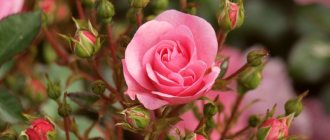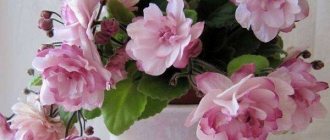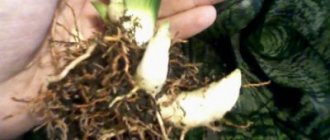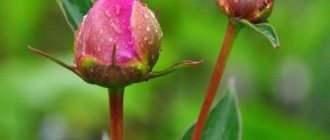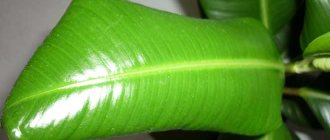Author:
Natalia
Category: Houseplants Published: February 24, 2019Last edits: January 11, 2021
plant (lat. Shefflera) , or shefflera , or umbrella tree , belongs to the largest genus of plants in the Araliaceae family, numbering about 200 species. The Schefflera flower received its name either in honor of the German botanist Jacob Christian Scheffler, who lived in the 18th century, or in honor of the Polish scientist Peter Ernest Jan Scheffler. In nature, representatives of this genus are vines, shrubs or trees, reaching a height of two and a half meters and growing in the tropics of Australia, Southeast Asia and the Pacific Islands. Some garden forms of shefflera with variegated foliage are in demand in culture; shefflera was grown in the house relatively recently. This is an exotic relaxation plant that absorbs negative energy like a sponge, saturates the air with oxygen and increases its humidity.
Description
Schefflera is a perennial plant of the Araliaceae family, growing in the tropical forests of Southeast Asia, Indonesia, and the Malay Archipelago. The numerous genus is represented by shrubs, vines and trees. Polish physician and botanist Johann Peter Ernst von Scheffler described several species for Reigers' book Tentamen Florae Gedanensis, published in 1776. For his great contribution to science, his name was given to this plant.
Schefflera in nature grows to varying heights from 4 to 20 meters; in indoor conditions, within two to three years it can reach 2 - 2.5 meters. Two species used in indoor floriculture are Schefflera actinophylla (umbrella tree) and Schefflera arboricola (dwarf umbrella tree). The palmate, leathery leaves of the flower grow from one origin, forming a fan very similar to the spokes of an umbrella. External similarity gave the plant the second name “umbrella tree”. Interestingly, in nature, a flower can settle on plant trunks, then a thick root reaches the soil and takes root itself.
Sheffler's photo
There are several popular types of shefflera: palmate, radiate, eight-leaved, tree-like.
Based on them, breeders have created varieties with original colors:
- Charlotte - has green leaves;
- Gerda, Gold Capells, Janine - leaves of yellow-green color with varying saturation;
- Melani - light yellow, almost white leaf color.
Plant species
Also check out these articles
- Methods for planting potatoes
- Clematis Multi Blue
- Lada pear variety
- The best varieties of yellow plum
More than 200 species of sheflera are known in nature. But no more than 10 are classified as decorative. This gives a certain choice because each of the indoor types has external unique features.
- Radiate or star-leaved schefflera has small leaves, up to 15 cm long and 5 cm wide. Each leaf consists of 8-15 leaf blades. It grows up to 3 meters in height, the leaves are green, the crown is massive.
- Arborescent schefflera produces compound leaves, each of which has 7-9 “fingers” on long petioles. The leaves are leathery, fleshy, with a shiny surface. Plant height is 1.2 meters. The color is green or motley.
- Schefflera palmate has 7-10 “fingers” on an elliptical leaf. The color of the tree is green with bright veins on the leaves. Grows as a compact bush.
- Eight-leaf shefflera is a rare but popular species. Gives 8-11 “fingers” per sheet. The leaves are large, up to 10 cm wide and up to 30 cm long. The leaf color is green with light veins.
In addition, domestic, decorative species include such species as: “Janine”, “Nora”, “Charlotte”, “Luseana” and “Gerda”.
Temperature, watering
All varieties of Schefflera are very light-loving, but cannot tolerate direct sunlight. The plant requires high air humidity and needs regular spraying. In the period until autumn, abundant watering is necessary, soaking the clod of earth, then the excess is poured out of the pan. In winter, shefflera is watered moderately. The best growing temperature in summer is considered to be 18-22 °C, in winter - 14-16 °C, a decrease to 12 °C is detrimental to the flower plant. When maintaining a plant, it is necessary to monitor drafts and isolate them in time.
Location
All flower varieties can tolerate insufficient lighting when grown indoors, but it will not be possible to grow a spectacular, densely foliated plant. Its internodes will become very elongated, the brightness of the leaves will fade, and the decorative effect will decrease. The best location in the apartment will be the window sills facing south with shading during hot midday hours.
Sheffler's photo
Shefflera should not be placed in brightly sunny places, although the lighting should be maximum.
Growing
To grow shefflera, the soil mixture is made up of turf, leaf, humus soil and sand in a ratio of 2:1:1:1. A layer of drainage must be placed at the bottom of the pot. If it is impossible for plants to grow freely, they form a less fertile mixture for it, which helps limit development. As an additional feeding, various liquid fertilizers for woody and deciduous ornamental plants are used, reducing the proportion specified by the manufacturer. The diluted solution is applied once every two weeks to the tree trunk. When caring for them, they try not to use special feeding sticks, as they provide more concentrated nutrition.
Photo
The photo shows Schefflera with proper care at home:
Those who grow Schefflera may find useful articles about caring for the plant, as well as methods of propagation.
Reproduction
The most suitable time to start propagating a flowering plant is spring.
Sheffler's photo
Propagation by cuttings
A reliable way to propagate new plant varieties is propagation by non-lignified stem cuttings. A young, healthy cutting no more than 10 cm high, cut at an acute angle, is placed in a glass with a solution of a growth stimulator (for example, Zircon, 1-2 drops per 1 liter of water) for 1-2 hours.
To root cuttings, choose a small-sized container in which root growth will take place under the most favorable conditions. In a large pot it is difficult to maintain optimal water conditions for the plant. To improve it, a drainage layer of expanded clay or perlite 3-4 cm high is poured onto the bottom of the pot. The soil mixture is made up of turf soil and sand in a 2:1 ratio or turf soil and humus in the same proportion.
The cuttings are placed in a selected container, covered with a plastic bag and placed in a well-lit place. Rooting cuttings are sprayed daily with a spray bottle. The plants gradually begin to ventilate. The first time for 10 minutes, then gradually increase the time. After 3-4 new leaves appear, the plantings are left uncovered for a day, covered at night.
Leaf propagation
You can try to propagate Schefflera by leaf. To do this, select a medium-sized leaf, trying to separate it from the heel (the part attached to the cutting). Then they are placed in a solution of a growth stimulator in settled water. The same means as for cuttings can serve as a stimulant. To grow from leaves, it is recommended to take a larger amount of planting material, since not all of them are able to take root. The leaves are placed in a nutrient solution, a cap is arranged from a suitable material that transmits light, and placed in a warm place with good lighting, avoiding sunlight. After roots form on the leaves, they are planted in small containers, creating greenhouse conditions for rooting using a cap made of transparent material. There is no need to ventilate rooting leaves at first; it is much more important to create suitable conditions for them to grow.
Reproduction by layering
The Schefflera plant can be forced to produce layering. To do this, an incision is made on the side stem, which is covered with layers of moss, cotton wool and film. Moss and cotton wool must be constantly kept moist so that an air shoot can form in this place within 1.5 months. It is carefully separated with the stem from the mother plant and planted in prepared soil.
Seed propagation method
The method of propagation by seeds is quite complicated due to their poor germination. In Russian conditions, according to experts, Schefflera does not bloom, so it cannot produce seeds. Seeds sold may not always meet germination requirements.
Planting work begins in February. The containers are selected wide and deep. A drainage layer of expanded clay is poured onto the bottom. The soil should consist of turf and humus soil. Before sowing, the seeds are soaked in a warm solution of any growth stimulant for 24 hours. They are placed in a sowing container to a depth of 5-6 cm, with a distance between them equal to 2 seed diameters. Cover with film and place in a bright place. Periodically, seeds and seedlings are ventilated by lifting the corner of the film. The room temperature is maintained at 22-25 °C. Transplantation of seedlings into separate pots is carried out when 3 true leaves grow. After this, they try to keep the plants at a temperature of +19 ° C for at least 3 months.
Sheffler's photo
Diseases and pests
Even with excellent care, shefflera can get sick or be attacked by pests.
Sign. Cause. Elimination methods.
Stretching the plant, the leaves are far apart. Elevated content temperature. Lack of light. Place in a cooler place. Adjust lighting.
Falling leaves. Low temperature content. Low indoor humidity. Excessive watering. Create a constant room temperature at +16-22 °C. Spray the leaves of the plant.
Water only when necessary, keeping the soil well moistened and draining excess water from the pan.
Paleness and yellowing of leaves. Lack of nutrients. From April to September, with an interval of 10 days, apply mineral complex fertilizers for decorative deciduous plants.
Fading of leaves. Lack of light. Move the flower to a more illuminated place, taking into account that variegated species require more diffused light than green ones.
Formation of dark spots on leaves. Abundant watering when kept at low temperatures. Adjust the amount and frequency of watering.
Watering is carried out with warm, settled water.
Formation of brown edging on leaves. Draft and insufficient watering. Elimination of drafts. Equalize the content temperature. Adjust watering.
Dry tips of leaves. Insufficient ambient humidity. Periodic spraying of leaves.
Root rotting. Abundant watering. Washing the roots in a solution of Fitosporin or Trichodermin, pruning damage and treating with crushed coal. Subsequent replanting into a new soil mixture with a good drainage layer at the bottom of the pot.
Blackening of stems and tops. Rotting of roots located in excessively wet soil. Infection with fungus or stem rot. Trim off the top above the rotting area. Treatment with antifungal drugs.
If there is insufficient control, Schefflera can be damaged by flower pests.
Symptoms. Pest. Control measures.
Detection of sticky dew, yellowing and falling of leaves. Shield. Isolation of the plant from others. Treatment with soap solution and insecticides.
- Aktara (4 g per 5 liters of water);
- Karbofos (6 g per 1 liter of water).
Formation of cobwebs on leaves. Yellowing and wilting of leaves. Spider mite. Increasing air humidity by spraying. Treatment with insecticides.
White coating on the leaves. Delay in plant development. Mealybug. Collection by hand. Treatment with insecticides. Increase in ambient air humidity.
Brown spots on the underside of the leaf, whitish on the top. Yellowing, drying and falling of leaves. Thrips. Treatment with soap solution. In the case of large colonies - treatment with insecticides.
Sheffler's photo
Schefflera - signs
When a shefler is accused of energy vampirism, one must admit that there is some truth in these accusations. Sheflera does absorb energy, but only negative energy, so don’t panic, but, on the contrary, try to spend some time next to her, especially if you are overcome by anxious or sad thoughts. Sheflera removes negativity and brings a feeling of harmony, helps to stop quarrels in the family. The best place in the house for sheflera is the bedroom. It is there that you relax during sleep, and the shefflera absorbs all your anxieties and neuroses, instilling vigor and peace.
Sheflera can be placed in the office or next to a schoolchild’s study corner, since esotericism suggests the plant’s ability to promote the productive acquisition of knowledge.
They also claim that with the help of sheflera you can predict the future. For example, those phenomena that we just explained by objective reasons are interpreted differently in the world of superstitions.
For example:
- if the leaves of the sheflera darken, this is a sign that there is a lot of negative energy in the room;
- if the cheflera falls off, this is a harbinger that someone living in the house will get sick, or a financial collapse will occur, the loss of a large amount of money;
- when the leaves of a plant curl up, this means a scandal with household members or work colleagues - it depends on where the plant is located;
- if the cheflera stopped its development for no apparent reason, this is an omen of future failures;
- unexpected intensive growth of the shefflera - a new addition to the family.
There is an opinion that a chef growing in the office attracts clients and good business partners, and, therefore, one can expect an increase in income. By the way, the plant helps most of all people born under the fire signs of the zodiac - Aries, Leo and Sagittarius.
Reviews
According to numerous reviews from gardeners, Schefflera is a fast-growing plant that is grateful for care. Contrary to the claims of breeders that it does not bloom in indoor conditions, a miracle happens in good hands. believe in you on her Internet page on April 20, 2015 she presented photographs of a flower with a released cone.
Irina also posted photographs of her variegated shefflera on March 14, 2016, accompanied by interesting material. The owner took care of him for more than 10 years and took him with her when moving. Schefflera bloomed after forced pruning due to pest damage. The hostess was pleased with the flower's gratitude.
Without exception, all amateur flower growers note the unpretentiousness of keeping shefflera, its rapid growth and the atmosphere that it creates in the home. Beautiful, original, feathery leaves delight the eye all year round. If a gardener is lucky enough to see a flower bloom, he rejoices doubly.
Sheffler's photo
Features of transplantation
Replanting a plant directly depends on the age of the shefflera; if the flower is still young, flower growers recommend replanting with the onset of each spring. Young shefflera does not experience any difficulties when transplanting, but the older the flower, the more difficult it is for it to take root in a new place. Therefore, you need to prepare pots of a larger volume than the previous ones in advance.
A fully grown Schefflera cannot be transplanted at all; it may not survive such stress.
You can prepare new soil yourself before replanting. To do this, you will need to make a soil mixture of peat, sand and humus (1:1:3).
